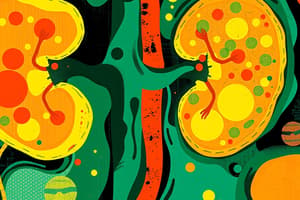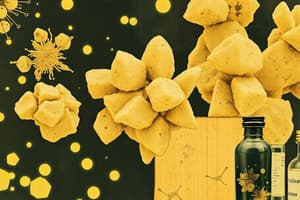Podcast
Questions and Answers
Which of the following crystals are considered to be significant?
Which of the following crystals are considered to be significant?
- Amorphous Urates
- Cystine (correct)
- Uric Acid
- Tyrosine (correct)
Amorphous phosphates dissolve when warmed.
Amorphous phosphates dissolve when warmed.
False (B)
What is the primary cause of sulfonamide crystallization?
What is the primary cause of sulfonamide crystallization?
Inadequate patient hydration
Uromodulin is secreted by renal tubular epithelial cells of the distal convoluted tubule and __________.
Uromodulin is secreted by renal tubular epithelial cells of the distal convoluted tubule and __________.
Which urinary crystals are known to be birefringent under polarized light?
Which urinary crystals are known to be birefringent under polarized light?
What condition is primarily associated with the presence of fat droplets in urine?
What condition is primarily associated with the presence of fat droplets in urine?
Abnormal crystals are usually found in __________ urine.
Abnormal crystals are usually found in __________ urine.
Which of the following is NOT a class of urinary casts?
Which of the following is NOT a class of urinary casts?
Calcium phosphate crystals can be differentiated from sulfonamide crystals using acetic acid.
Calcium phosphate crystals can be differentiated from sulfonamide crystals using acetic acid.
What is the shape of calcium oxalate dihydrate crystals?
What is the shape of calcium oxalate dihydrate crystals?
Match the following urinary cast types with their descriptions:
Match the following urinary cast types with their descriptions:
Flashcards are hidden until you start studying
Study Notes
Urine Crystals
- Most urine crystals are not clinically significant
- Crystals are formed by the precipitation of urine solutes
- The presence of crystals depends on temperature, solute concentration, and pH
- Many crystals form in refrigerated specimens
- Crystals found in freshly voided urine are usually associated with concentrated urine.
Types of Crystals
-
Normal Crystals in Acid Urine*
-
Uric Acid: rhombic, flat plates, wedges, rosettes. Color: yellow-brown. May be colorless and six-sided.
-
Amorphous Urates: Granular sediment. Color: yellow-brown or pink.
-
Normal Crystals in Acid/Neutral Urine*
-
Calcium Oxalate: Envelope-shaped (dihydrate) or oval or dumbbell-shaped (monohydrate). Color: colorless.
-
Normal Crystals in Alkaline Urine*
-
Amorphous Phosphates: Granular sediment. Color: white-colorless.
-
Calcium Phosphate: Flat rectangular plates or rosettes. Color: colorless
-
Triple Phosphate: “coffin-lid” prism or fern leaf shape. Color: colorless.
-
Ammonium Biurate: Spicule-covered spheres "thorny apples". Color: yellow-brown.
-
Calcium Carbonate: Small dumbbell or spherical. Color: Colorless.
-
Abnormal Crystals in Acid Urine*
-
Cystine: Hexagonal plates. Color: colorless. Found in cystinuria (a metabolic disorder).
-
Cholesterol: rectangular plates with notched corners. Color: colorless. Associated with lipiduria, including nephrotic syndrome.
-
Leucine: Spheres with concentric circles and radial striations. Color: yellow-brown. Often accompanied by tyrosine crystals.
-
Tyrosine: Fine needles in clumps or rosettes. Color: colorless to yellow. Seen in conjunction with leucine crystals.
-
Bilirubin: Clumped needles or granules. Color: yellow. Seen in disorders that produce renal tubular damage.
-
Sulfonamides: Variety of shapes (needles, rhombics, whetstones) and colors (colorless to yellow-brown) due to different types of sulfonamides.
-
Radiographic Dye: Flat plates. Color: colorless. Highly birefringent.
-
Ampicillin: Needles that form bundles after refrigeration. Color: colorless.
Urinary Casts
- Urinary casts are composed primarily of uromodulin (Tamm-Horsfall protein).
- Uromodulin is excreted at a constant rate under normal conditions and increases during stress and exercise.
- The size and shape of a cast depend on the tubule where it was formed.
- Casts can contain other elements from the tubular filtrate such as cells, granules, pigments, crystals, bacteria
- Casts are typically cylindrical, have parallel sides, and rounded ends.
- Do not have dark edges.
Types of Casts
- Hyaline Casts: Made up entirely of uromodulin. Often difficult to see due to low refractive index.
- Red Blood Cell Casts: Contain red blood cells in the protein matrix.
- White Blood Cell Casts: Contain neutrophils in the protein matrix.
- Renal Tubular Epithelial (RTE) Casts: Contain renal tubular epithelial cells, indicating tubular destruction.
- Granular Casts: Composed of disintegrating cellular casts.
- Waxy Casts: Highly refractive and brittle. Represent extreme urine stasis.
- Broad Casts: Wide casts and typically indicate destruction and widening of the tubular walls.
- Fatty Casts: Contain fat droplets and oval fat bodies.
Oval Fat Bodies
- Lipid-containing renal tubular epithelial cells.
- May contain cholesterol, triglycerides, or neutral fat.
Reporting Urine Microscopy Results
- The presence of casts is reported per low-power field (lpf).
- Cells are reported per high-power field (hpf).
- Bacteria and crystals may be reported according to laboratory policies.
Studying That Suits You
Use AI to generate personalized quizzes and flashcards to suit your learning preferences.


